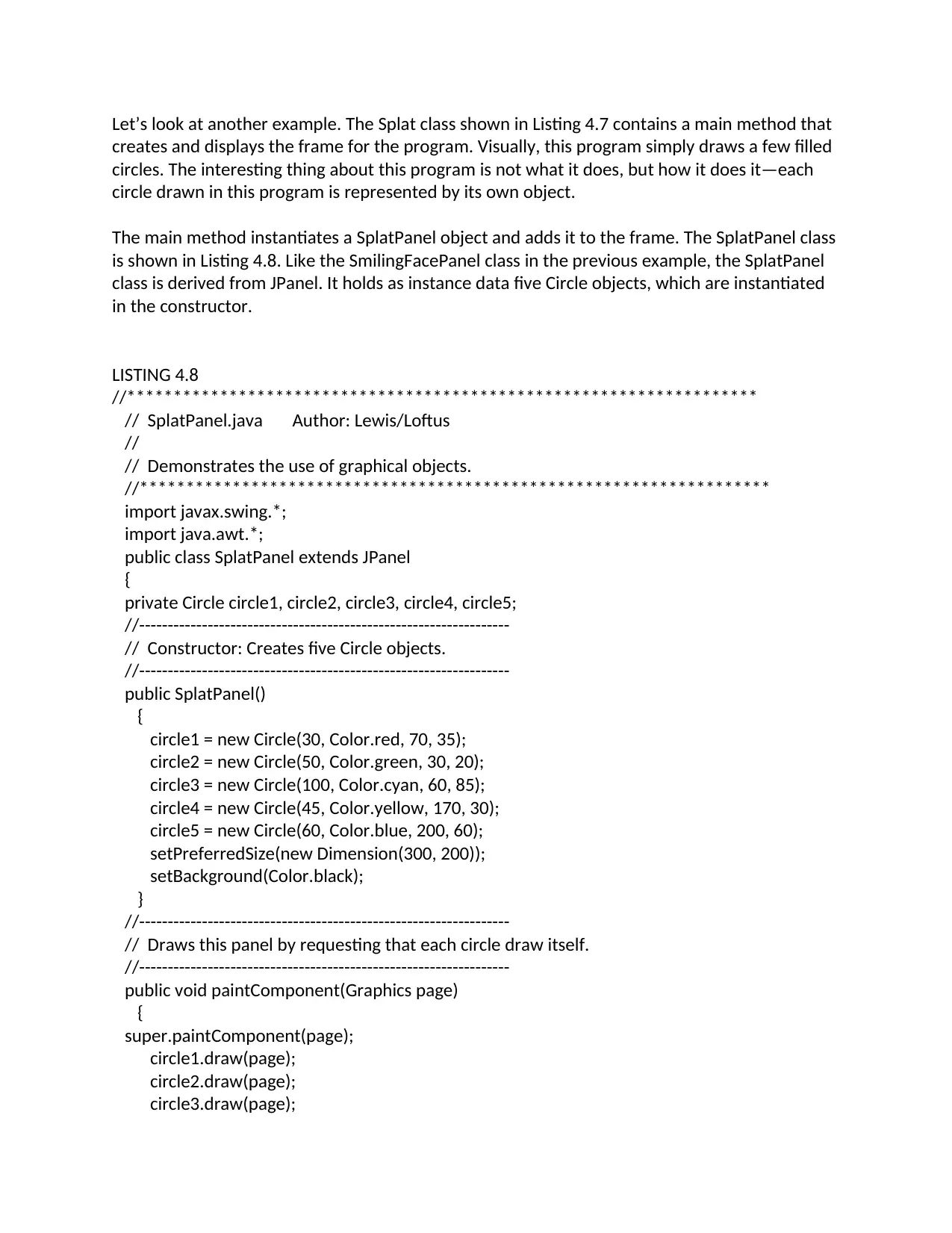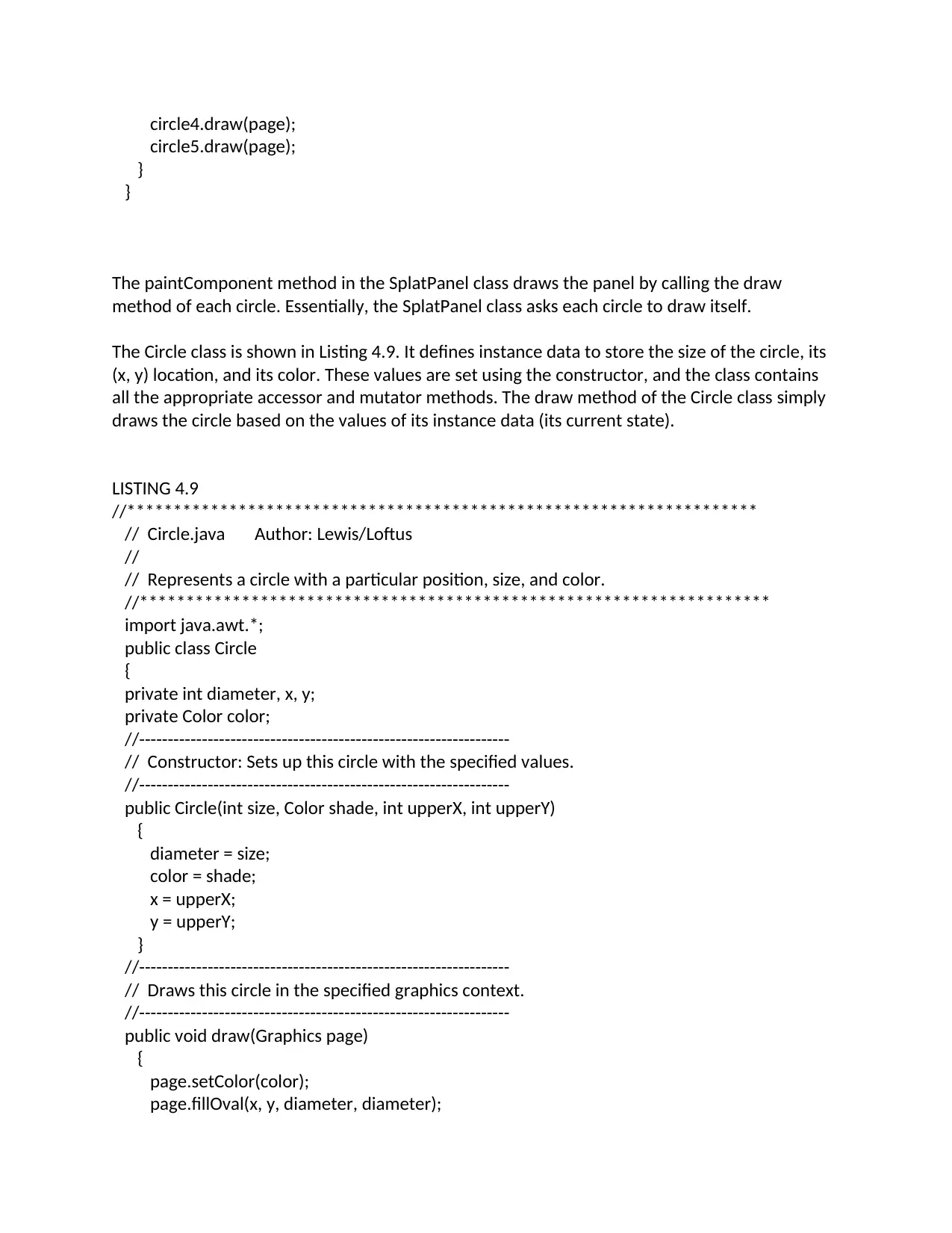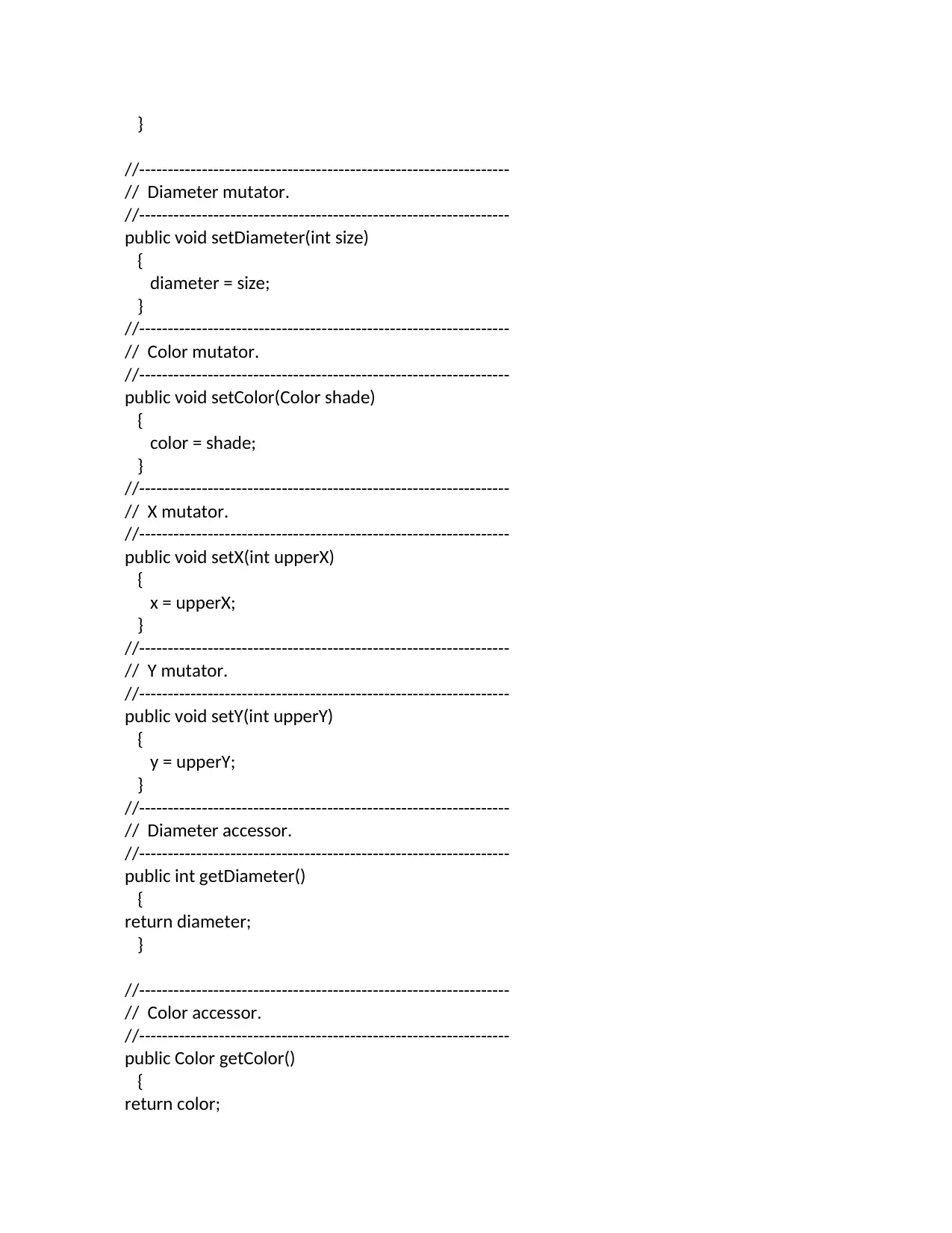Splat Program Implementation
VerifiedAdded on 2019/09/16
|5
|1704
|173
Practical Assignment
AI Summary
This practical assignment involves implementing the "Splat" program in Java, which demonstrates fundamental object-oriented programming concepts. The program draws multiple circles on a panel, each circle represented by its own object of the `Circle` class. The `Circle` class encapsulates data (diameter, color, x, y coordinates) and methods to draw itself. The `SplatPanel` class manages an array of `Circle` objects and uses the `paintComponent` method to draw them. The main `Splat` class sets up the graphical user interface (GUI) frame. This assignment showcases object encapsulation, instance data, and method calls, reinforcing core OOP principles. The provided code listings (4.7, 4.8, and 4.9) detail the implementation of the `Splat`, `SplatPanel`, and `Circle` classes respectively. The assignment focuses on understanding how each class interacts and contributes to the overall functionality of the program.

LISTING 4.7
//********************************************************************
// Splat.java Author: Lewis/Loftus
//
// Demonstrates the use of graphical objects.
//********************************************************************
import javax.swing.*;
import java.awt.*;
public class Splat
{
//-----------------------------------------------------------------
// Presents a collection of circles.
//-----------------------------------------------------------------
public static void main(String[] args)
{
JFrame frame = new JFrame("Splat");
frame.setDefaultCloseOperation(JFrame.EXIT_ON_CLOSE);
frame.getContentPane().add(new SplatPanel());
frame.pack();
frame.setVisible(true);
}
}
//********************************************************************
// Splat.java Author: Lewis/Loftus
//
// Demonstrates the use of graphical objects.
//********************************************************************
import javax.swing.*;
import java.awt.*;
public class Splat
{
//-----------------------------------------------------------------
// Presents a collection of circles.
//-----------------------------------------------------------------
public static void main(String[] args)
{
JFrame frame = new JFrame("Splat");
frame.setDefaultCloseOperation(JFrame.EXIT_ON_CLOSE);
frame.getContentPane().add(new SplatPanel());
frame.pack();
frame.setVisible(true);
}
}
Paraphrase This Document
Need a fresh take? Get an instant paraphrase of this document with our AI Paraphraser

Let’s look at another example. The Splat class shown in Listing 4.7 contains a main method that
creates and displays the frame for the program. Visually, this program simply draws a few filled
circles. The interesting thing about this program is not what it does, but how it does it—each
circle drawn in this program is represented by its own object.
The main method instantiates a SplatPanel object and adds it to the frame. The SplatPanel class
is shown in Listing 4.8. Like the SmilingFacePanel class in the previous example, the SplatPanel
class is derived from JPanel. It holds as instance data five Circle objects, which are instantiated
in the constructor.
LISTING 4.8
//********************************************************************
// SplatPanel.java Author: Lewis/Loftus
//
// Demonstrates the use of graphical objects.
//********************************************************************
import javax.swing.*;
import java.awt.*;
public class SplatPanel extends JPanel
{
private Circle circle1, circle2, circle3, circle4, circle5;
//-----------------------------------------------------------------
// Constructor: Creates five Circle objects.
//-----------------------------------------------------------------
public SplatPanel()
{
circle1 = new Circle(30, Color.red, 70, 35);
circle2 = new Circle(50, Color.green, 30, 20);
circle3 = new Circle(100, Color.cyan, 60, 85);
circle4 = new Circle(45, Color.yellow, 170, 30);
circle5 = new Circle(60, Color.blue, 200, 60);
setPreferredSize(new Dimension(300, 200));
setBackground(Color.black);
}
//-----------------------------------------------------------------
// Draws this panel by requesting that each circle draw itself.
//-----------------------------------------------------------------
public void paintComponent(Graphics page)
{
super.paintComponent(page);
circle1.draw(page);
circle2.draw(page);
circle3.draw(page);
creates and displays the frame for the program. Visually, this program simply draws a few filled
circles. The interesting thing about this program is not what it does, but how it does it—each
circle drawn in this program is represented by its own object.
The main method instantiates a SplatPanel object and adds it to the frame. The SplatPanel class
is shown in Listing 4.8. Like the SmilingFacePanel class in the previous example, the SplatPanel
class is derived from JPanel. It holds as instance data five Circle objects, which are instantiated
in the constructor.
LISTING 4.8
//********************************************************************
// SplatPanel.java Author: Lewis/Loftus
//
// Demonstrates the use of graphical objects.
//********************************************************************
import javax.swing.*;
import java.awt.*;
public class SplatPanel extends JPanel
{
private Circle circle1, circle2, circle3, circle4, circle5;
//-----------------------------------------------------------------
// Constructor: Creates five Circle objects.
//-----------------------------------------------------------------
public SplatPanel()
{
circle1 = new Circle(30, Color.red, 70, 35);
circle2 = new Circle(50, Color.green, 30, 20);
circle3 = new Circle(100, Color.cyan, 60, 85);
circle4 = new Circle(45, Color.yellow, 170, 30);
circle5 = new Circle(60, Color.blue, 200, 60);
setPreferredSize(new Dimension(300, 200));
setBackground(Color.black);
}
//-----------------------------------------------------------------
// Draws this panel by requesting that each circle draw itself.
//-----------------------------------------------------------------
public void paintComponent(Graphics page)
{
super.paintComponent(page);
circle1.draw(page);
circle2.draw(page);
circle3.draw(page);

circle4.draw(page);
circle5.draw(page);
}
}
The paintComponent method in the SplatPanel class draws the panel by calling the draw
method of each circle. Essentially, the SplatPanel class asks each circle to draw itself.
The Circle class is shown in Listing 4.9. It defines instance data to store the size of the circle, its
(x, y) location, and its color. These values are set using the constructor, and the class contains
all the appropriate accessor and mutator methods. The draw method of the Circle class simply
draws the circle based on the values of its instance data (its current state).
LISTING 4.9
//********************************************************************
// Circle.java Author: Lewis/Loftus
//
// Represents a circle with a particular position, size, and color.
//********************************************************************
import java.awt.*;
public class Circle
{
private int diameter, x, y;
private Color color;
//-----------------------------------------------------------------
// Constructor: Sets up this circle with the specified values.
//-----------------------------------------------------------------
public Circle(int size, Color shade, int upperX, int upperY)
{
diameter = size;
color = shade;
x = upperX;
y = upperY;
}
//-----------------------------------------------------------------
// Draws this circle in the specified graphics context.
//-----------------------------------------------------------------
public void draw(Graphics page)
{
page.setColor(color);
page.fillOval(x, y, diameter, diameter);
circle5.draw(page);
}
}
The paintComponent method in the SplatPanel class draws the panel by calling the draw
method of each circle. Essentially, the SplatPanel class asks each circle to draw itself.
The Circle class is shown in Listing 4.9. It defines instance data to store the size of the circle, its
(x, y) location, and its color. These values are set using the constructor, and the class contains
all the appropriate accessor and mutator methods. The draw method of the Circle class simply
draws the circle based on the values of its instance data (its current state).
LISTING 4.9
//********************************************************************
// Circle.java Author: Lewis/Loftus
//
// Represents a circle with a particular position, size, and color.
//********************************************************************
import java.awt.*;
public class Circle
{
private int diameter, x, y;
private Color color;
//-----------------------------------------------------------------
// Constructor: Sets up this circle with the specified values.
//-----------------------------------------------------------------
public Circle(int size, Color shade, int upperX, int upperY)
{
diameter = size;
color = shade;
x = upperX;
y = upperY;
}
//-----------------------------------------------------------------
// Draws this circle in the specified graphics context.
//-----------------------------------------------------------------
public void draw(Graphics page)
{
page.setColor(color);
page.fillOval(x, y, diameter, diameter);
⊘ This is a preview!⊘
Do you want full access?
Subscribe today to unlock all pages.

Trusted by 1+ million students worldwide

}
//-----------------------------------------------------------------
// Diameter mutator.
//-----------------------------------------------------------------
public void setDiameter(int size)
{
diameter = size;
}
//-----------------------------------------------------------------
// Color mutator.
//-----------------------------------------------------------------
public void setColor(Color shade)
{
color = shade;
}
//-----------------------------------------------------------------
// X mutator.
//-----------------------------------------------------------------
public void setX(int upperX)
{
x = upperX;
}
//-----------------------------------------------------------------
// Y mutator.
//-----------------------------------------------------------------
public void setY(int upperY)
{
y = upperY;
}
//-----------------------------------------------------------------
// Diameter accessor.
//-----------------------------------------------------------------
public int getDiameter()
{
return diameter;
}
//-----------------------------------------------------------------
// Color accessor.
//-----------------------------------------------------------------
public Color getColor()
{
return color;
//-----------------------------------------------------------------
// Diameter mutator.
//-----------------------------------------------------------------
public void setDiameter(int size)
{
diameter = size;
}
//-----------------------------------------------------------------
// Color mutator.
//-----------------------------------------------------------------
public void setColor(Color shade)
{
color = shade;
}
//-----------------------------------------------------------------
// X mutator.
//-----------------------------------------------------------------
public void setX(int upperX)
{
x = upperX;
}
//-----------------------------------------------------------------
// Y mutator.
//-----------------------------------------------------------------
public void setY(int upperY)
{
y = upperY;
}
//-----------------------------------------------------------------
// Diameter accessor.
//-----------------------------------------------------------------
public int getDiameter()
{
return diameter;
}
//-----------------------------------------------------------------
// Color accessor.
//-----------------------------------------------------------------
public Color getColor()
{
return color;
Paraphrase This Document
Need a fresh take? Get an instant paraphrase of this document with our AI Paraphraser

}
//-----------------------------------------------------------------
// X accessor.
//-----------------------------------------------------------------
public int getX()
{
return x;
}
//-----------------------------------------------------------------
// Y accessor.
//-----------------------------------------------------------------
public int getY()
{
return y;
}
}
The Splat program embodies fundamental object-oriented thinking. Each circle manages itself
and will draw itself in whatever graphics context you pass it. Each Circle object maintains its
own state. The Circle class is defined in a way that can be used in other situations and
programs.
//-----------------------------------------------------------------
// X accessor.
//-----------------------------------------------------------------
public int getX()
{
return x;
}
//-----------------------------------------------------------------
// Y accessor.
//-----------------------------------------------------------------
public int getY()
{
return y;
}
}
The Splat program embodies fundamental object-oriented thinking. Each circle manages itself
and will draw itself in whatever graphics context you pass it. Each Circle object maintains its
own state. The Circle class is defined in a way that can be used in other situations and
programs.
1 out of 5
Your All-in-One AI-Powered Toolkit for Academic Success.
+13062052269
info@desklib.com
Available 24*7 on WhatsApp / Email
![[object Object]](/_next/static/media/star-bottom.7253800d.svg)
Unlock your academic potential
Copyright © 2020–2026 A2Z Services. All Rights Reserved. Developed and managed by ZUCOL.
